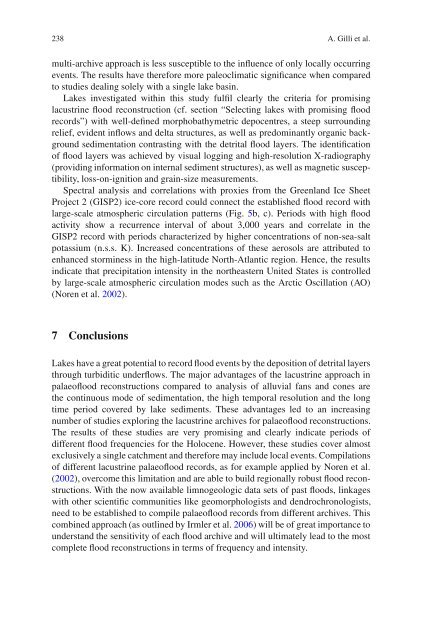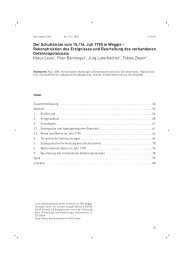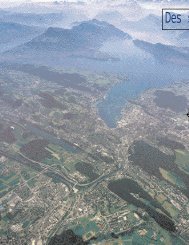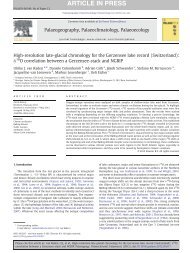Lake Sediments as Archives of Recurrence Rates and ... - Eawag
Lake Sediments as Archives of Recurrence Rates and ... - Eawag
Lake Sediments as Archives of Recurrence Rates and ... - Eawag
Create successful ePaper yourself
Turn your PDF publications into a flip-book with our unique Google optimized e-Paper software.
238 A. Gilli et al.<br />
multi-archive approach is less susceptible to the influence <strong>of</strong> only locally occurring<br />
events. The results have therefore more paleoclimatic significance when compared<br />
to studies dealing solely with a single lake b<strong>as</strong>in.<br />
<strong>Lake</strong>s investigated within this study fulfil clearly the criteria for promising<br />
lacustrine flood reconstruction (cf. section “Selecting lakes with promising flood<br />
records”) with well-defined morphobathymetric depocentres, a steep surrounding<br />
relief, evident inflows <strong>and</strong> delta structures, <strong>as</strong> well <strong>as</strong> predominantly organic background<br />
sedimentation contr<strong>as</strong>ting with the detrital flood layers. The identification<br />
<strong>of</strong> flood layers w<strong>as</strong> achieved by visual logging <strong>and</strong> high-resolution X-radiography<br />
(providing information on internal sediment structures), <strong>as</strong> well <strong>as</strong> magnetic susceptibility,<br />
loss-on-ignition <strong>and</strong> grain-size me<strong>as</strong>urements.<br />
Spectral analysis <strong>and</strong> correlations with proxies from the Greenl<strong>and</strong> Ice Sheet<br />
Project 2 (GISP2) ice-core record could connect the established flood record with<br />
large-scale atmospheric circulation patterns (Fig. 5b, c). Periods with high flood<br />
activity show a recurrence interval <strong>of</strong> about 3,000 years <strong>and</strong> correlate in the<br />
GISP2 record with periods characterized by higher concentrations <strong>of</strong> non-sea-salt<br />
pot<strong>as</strong>sium (n.s.s. K). Incre<strong>as</strong>ed concentrations <strong>of</strong> these aerosols are attributed to<br />
enhanced storminess in the high-latitude North-Atlantic region. Hence, the results<br />
indicate that precipitation intensity in the northe<strong>as</strong>tern United States is controlled<br />
by large-scale atmospheric circulation modes such <strong>as</strong> the Arctic Oscillation (AO)<br />
(Noren et al. 2002).<br />
7 Conclusions<br />
<strong>Lake</strong>s have a great potential to record flood events by the deposition <strong>of</strong> detrital layers<br />
through turbiditic underflows. The major advantages <strong>of</strong> the lacustrine approach in<br />
palae<strong>of</strong>lood reconstructions compared to analysis <strong>of</strong> alluvial fans <strong>and</strong> cones are<br />
the continuous mode <strong>of</strong> sedimentation, the high temporal resolution <strong>and</strong> the long<br />
time period covered by lake sediments. These advantages led to an incre<strong>as</strong>ing<br />
number <strong>of</strong> studies exploring the lacustrine archives for palae<strong>of</strong>lood reconstructions.<br />
The results <strong>of</strong> these studies are very promising <strong>and</strong> clearly indicate periods <strong>of</strong><br />
different flood frequencies for the Holocene. However, these studies cover almost<br />
exclusively a single catchment <strong>and</strong> therefore may include local events. Compilations<br />
<strong>of</strong> different lacustrine palae<strong>of</strong>lood records, <strong>as</strong> for example applied by Noren et al.<br />
(2002), overcome this limitation <strong>and</strong> are able to build regionally robust flood reconstructions.<br />
With the now available limnogeologic data sets <strong>of</strong> p<strong>as</strong>t floods, linkages<br />
with other scientific communities like geomorphologists <strong>and</strong> dendrochronologists,<br />
need to be established to compile palae<strong>of</strong>lood records from different archives. This<br />
combined approach (<strong>as</strong> outlined by Irmler et al. 2006) will be <strong>of</strong> great importance to<br />
underst<strong>and</strong> the sensitivity <strong>of</strong> each flood archive <strong>and</strong> will ultimately lead to the most<br />
complete flood reconstructions in terms <strong>of</strong> frequency <strong>and</strong> intensity.








